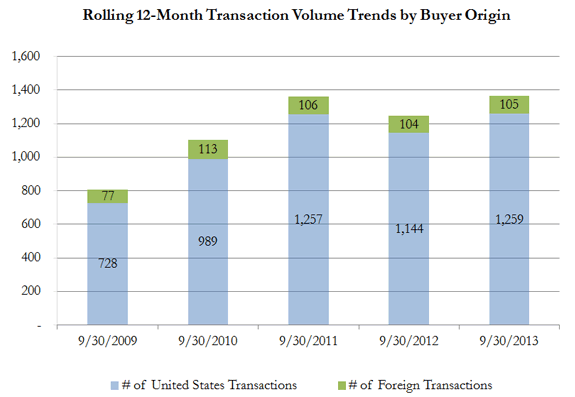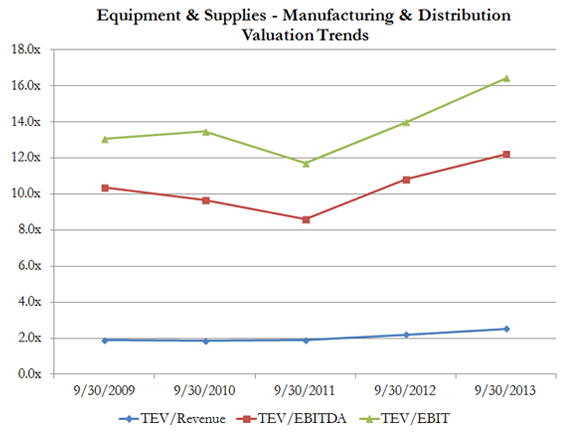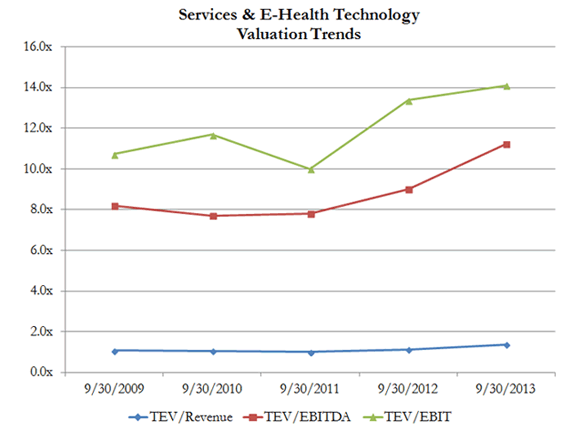Affordable Care Act: A Healthcare Industry Game Changer
Continued consolidations among healthcare providers and suppliersÂ
David Jasmund examines the effect the Affordable Care Act (ACA) is having on mergers and acquisitions across the healthcare service and supply sector. Using Third Quarter data, Jasmund displays where the opportunities and challenges are occurring within the overall industry.
The president, Congress, and supporters originally called the new healthcare legislation the Patient Protection and Affordable Care Act (PPACA). It was then shortened or referred to as the Affordable Care Act (ACA), and is now lovingly, or perhaps disparagingly, referred to as Obamacare by supporters and naysayers. Whatever you call the law, whatever you think about it, or whatever the final outcome, one thing is for certain; ACA has permanently changed the healthcare industry. The ACA basically has two goals; to extend insurance coverage to the nation’s uninsured and to slow the growth in healthcare spending. The impact of the law on health-care companies will largely depend on the balance between two conflicting forces; 1) the benefit from increased volumes as more people carry health insurance and 2) pricing pressure due to government reimbursement cuts and shifts in the relative bargaining power of healthcare payers and providers. The law has driven consolidation among healthcare payers and has also spurred change and consolidation among the healthcare supplier and service provider industries.Â
One look at the pickup in the number of healthcare industry mergers and acquisition (M&A) transactions since the 2010 passage confirms this consolidation trend.

ACA: A Healthcare Industry Game Changer
Source: PCE Industry Update–Healthcare– Third Quarter 2013
The third quarter of 2013 saw a continuation of this trend with a pickup in transaction volume in every sector of the healthcare industry. Additionally, confidence in the publicly traded healthcare companies when measured by “Total Enterprise Value” increased across the industry despite across the board compression in the industry’s profitability or “Gross Margins” and “EBITDA Margins.”
While all sectors of healthcare experienced a third quarter pickup in M&A activity over Q2 2013, the equipment & supplies sector year-to-date activity is on track to experience a low not seen since 2009. Through the third quarter, only 147 equipment & supply deals have been reported in 2013, a rate down 12 percent over the average activity seen during the prior three years. Hardest hit amongst this sector are medical device manufacturing companies. According to Capital IQ, 2013 year-to-date medical device M&A volume stands at only 88 deals, a rate down over 16 percent for the average activity seen the prior three years. Most industry followers attribute this slowdown to the implementation of the 2.3 percent excise tax that went into effect on January 1 as part of the ACA. Despite this recent drop in activity, most industry observers expect activity to pick back up as the industry manufacturers consolidate to improve their pricing power in order to offset the excise tax as well as pricing pressure and declining procedure volumes imposed by healthcare payers. One look at the bullish increase in the market value of equipment & supplies public companies certainly leads one to believe that the public market may agree.
Source: PCE Industry Update–Healthcare– Third Quarter 2013
Since the passage of the new law in 2010, M&A within the healthcare services and e-health technology sector has consistently exceeded the activity of the other healthcare industry sectors. This is attributable to ACA’s emphasis on innovation within the delivery of healthcare. The law led to the creation of accountable-care organizations (ACOs), which allow hospitals and service providers to share cost savings or receive payments for achieving quality outcomes. This has and will continue to create opportunity for consolidation among service providers. In order to accomplish this, the ACOs must be able to provide integrated access to information among all of a patient’s providers. The healthcare providers must then apply information technology solutions to develop new and more efficient ways of delivering care with better outcomes to reduce costs. The push by the larger, better-capitalized hospitals and healthcare systems for integrated high-cost technologies, such as electronic health records, continues to drive consolidation and investment into e-health technology companies.
Source: PCE Industry Update–Healthcare– Third Quarter 2013
Regardless of how the ACA is ultimately implemented, this legislation has been a game-changer for the healthcare industry. Even in the event that the ACA naysayers have their way and successfully repeal all or even a portion of this law, ACA has permanently changed and reshaped the healthcare landscape forever. Cost pressures and uncertainty will bring more attractive healthcare companies to the forefront. Investors and strategic buyers will continue to pursue the acquisition of the market innovators to earn high investment returns or position themselves for future growth.
Reprinted with permission from PCE Investment Bankers Trends & Deals, Oct. 2013.
i“Understanding the Affordable Care Act”, Morningstar Stock Investor (November 2013 Vol. 13, No. 5), pp. 1-3.
David J. Jasmund is an investment banker with PCE Holdings, Inc., based in Winter Park, Fl. He can be reached at djasmund@pcecompanies.com.Â




